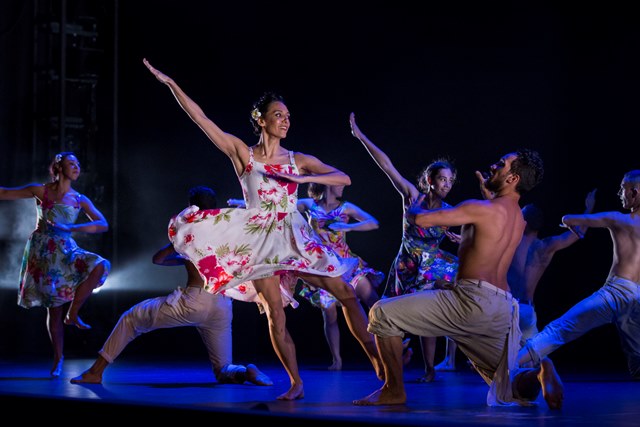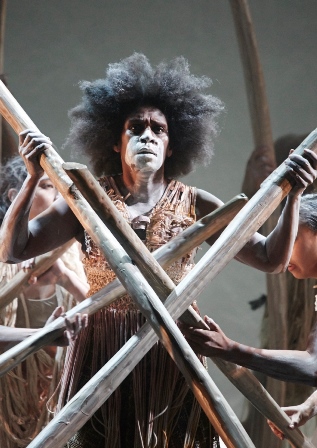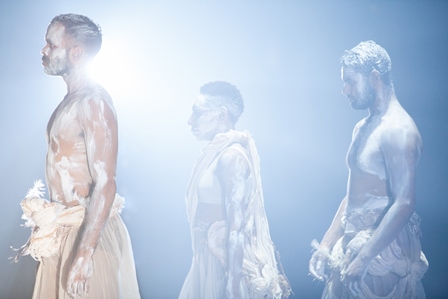9 July 2015, Canberra Theatre
It would be hard to find two such disparate works as the two that make up lore, Bangarra Dance Theatre’s latest program curated by the company’s artistic director, Stephen Page. I.B.I.S, the opener, is the debut choreographic work from two artists from the Torres Strait Islands, Deborah Brown and Waangenga Blanco, and it is filled with fun, laughter and joyous dancing. Sheoak is from established choreographer, Frances Rings, and has a more sombre tone. While this work ends on a note of hope, it deals with serious issues that have powerful political overtones. But both are thrilling to watch and give us, once more, an insight into the depth of talent in the Bangarra family, which includes not just the dancers and choreographers, but the whole creative team.
I.B.I.S begins in a supermarket belonging to the Island Board of Industry and Services (hence the name I.B.I.S) and its customers are there not just to shop, but to socialise as well. We know though that they also shop there. A cheery dance by the women, who manipulate metal shopping baskets, makes that quite clear.

As the work progresses, however, we meet the fishermen who catch the sea creatures that fill the freezer cabinets. And we even meet the sea creatures themselves when they escape from the freezer at night.
But the essence of I.B.I.S is the community spirit that permeates Island life. There is a wonderful picnic-style section where the men dance for the women and then the women dance for the men, amid much shouting and many exclamations. And the highlight is the final section, which comes almost unexpectedly after it seems that the show is over. The full ensemble returns wearing traditional island skirts and headdresses and performs an absolutely exhilarating traditional dance, which clearly shows the many influences from Melanesia and Polynesia that characterise the culture of the Torres Strait Islands.
Sheoak focuses on environmental issues. The sheoak tree, the grandmother tree in indigenous lore, is endangered and, in the opening scene, we see pyramid of dancers gradually collapsing. The metaphor of the tree as Aboriginal society continues, and the keeper of the place in which the tree grows mourns its loss. Societal dysfunction results and the community faces the challenges of operating in a new environment. Choreographically, Rings has given the dancers stumbling movements that make them look disoriented. And a stunning duet between Elma Kris and Yolanda Yowatta is a highlight as an encounter between the old order and the new. Yowatta is currently a trainee with Bangarra and her beautifully fluid style of moving is an absolute delight.
Elma Kris made a major contribution to both works. In I.B.I.S she played the role of the owner of the store and her opening dance with a mop was a delight. But it was in Sheoak as the keeper of the lore that her strength as a performer, her commanding presence, was so clear. Hope for the future shone through.

As ever with Bangarra productions, lore was enhanced by a strong visual design. Karen Norris’ lighting for Sheoak was especially outstanding. It created a somewhat eerie atmosphere that set the work in an indefinable time. Jacob Nash continues to create minimal but very effective sets and Jennifer Irwin’s costumes again show her exceptional layering of textiles, notably in Sheoak. The evocative original scores were by David Page for Sheoak and Steve Francis for I.B.I.S.
If I have a grumble, it is that I would have liked to have seen better unison dancing (when unison was an intended part of the choreography). But it is hard to grumble when we are presented with the magnificent theatricality that characterised lore.
Michelle Potter, 15 July 2015
Featured image: Sheoak with Luke Currie Richardson, Yolanda Lowatta and Beau Dean Riley Smith. Photo: © Jacob Nash
